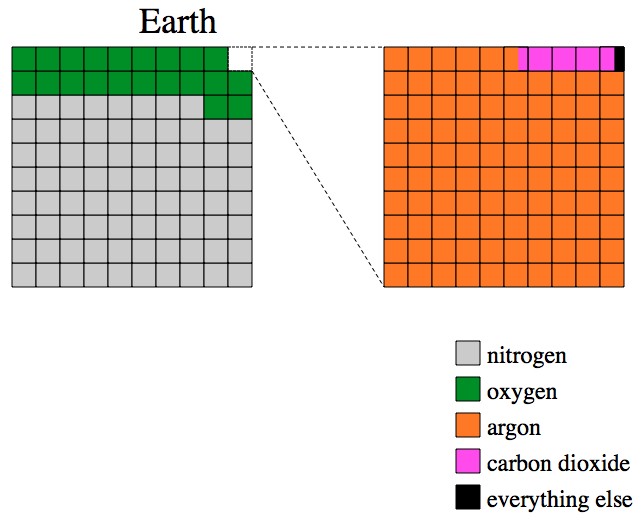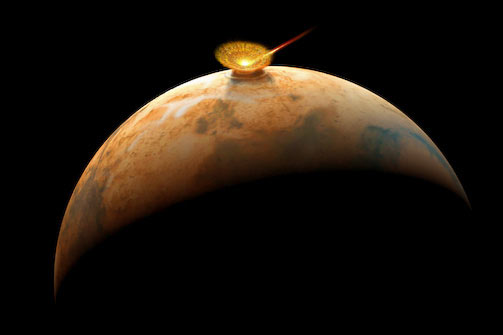Physicist: In terms of feasibility: no. In terms of being remotely possible: yes, but probably not permanently.
Mars is much colder than Earth, has no water, and effectively no air. On the up side, unlike many planets, you can stand on Mars (it’s solid), and its day is nearly the same as Earth’s (24 hours, 40 minutes). Despite the bad news that follows, Mars is the best candidate for terraforming (making more Earth-like).
First problem: Mars is cold. The most searing heat wave on Mars would barely melt water. Unfortunately, this is a problem with Mars’ distance from the Sun. The only way to get Mars warm would be to create an intense greenhouse effect by mixing up the right atmosphere.

The size of the Sun as seen from Earth (left) compared to the size of the Sun as seen from Mars (right). There's not much sunlight, and not much that can be done about it.
So we need to add an atmosphere, which is pretty hard to come by. Mars has a little under 1% of the atmosphere we enjoy on Earth, so we’d be practically starting from scratch.

Our atmosphere is 99% nitrogen and oxygen. The last 1% is almost all argon. Carbon dioxide makes up a paltry 0.04% of our air. Moral is: we have a big, complicated atmosphere.
Mars did, at one time, have an atmosphere. The best theory today is that when Mars lost its magnetic field the Solar wind, that would otherwise be deflected, was free to gradually strip away Mars’ air. Mars also has about 1/3 of Earth’s gravity, making the process substantially easier.
So there’s some possibility that even if we did manage to establish a dense, warm atmosphere that it would suffer the same fate as the first atmosphere (after several thousand years). Every couple of millennia it may be necessary to touch-up the atmosphere.
The amount of green house gasses you’d need to keep the surface water liquid is very likely to be toxic. It’s been shown that human beings can survive CO2 concentrations as high as 4% (the research so far hasn’t killed anybody, but it has made some people sick). Unfortunately, concentrations higher than 4% are likely to be necessary to maintain a liquid water environment, and even 1% isn’t particularly healthy.

The atmosphere of Mars at the same scale as the picture above. If you were to stand on Mars without a space suit you would get a spectacular full-body hickey. In fact, the low (almost zero) pressure is probably the first thing that would kill you, so wear a space suit if you're going to Mars.
Other gases can be substituted for CO2 to create a green house effect. But most have other problems: too much methane could make the atmosphere explosive, and nitrous oxide tends to make people… weird. The best candidate is probably sulfur-hexafluoride (SF6), which is more than 20,000 times more effective than CO2 as a greenhouse gas, and is non-toxic. There are, however, more subtle drawbacks to SF6 and it would be pretty difficult to synthesize enough.
As the Sun gets brighter, we should find that in a couple billion years Mars will be in the “goldilocks zone” (and Earth won’t) and that whole “toxic concentrations of green house gas” problem becomes moot. It’ll be naturally warm enough in Mars’ orbit for liquid water.
It would also be nice to have oceans on Mars. Oceans are really good at circulating heat, “smoothing out” temperature fluctuations, and generally give rise to climatological niceness. Our oceans can store and release just a hell of a lot more heat than our atmosphere. In order to create oceans on 2/3 of Mars’ surface with a depth of 3 to 4 km (like our oceans) would require about 350 million cubic km of water. Luckily, we’ve got big blobs of water (or ice at least) flying around the solar system in the form of comets. But to top off Mars’ oceans would take somewhere around 3 to 4 million comets. To date there are only around 6,000 known comets, but there are likely to be billions or trillions more out past Pluto’s orbit. I wonder if Halley’s comet would be protected as a historical landmark?
Comets are convenient because the water they carry doesn’t have to be hauled off of another planet’s surface (which costs a lot of energy). Instead you can “nudge” them into orbits which intersect Mars. It’s worth noting: you wouldn’t want to be anywhere on the surface when the oceans are being set up.
Water is a great material because it’s mostly oxygen, which is the most important part of the atmosphere (in my very humble opinion). You could turn some of the new Martian seas into the bulk of the new atmosphere with gigantic electrolysis plants, which would use electricity to break down the water (H2O) into hydrogen and oxygen.
If the goal is just to have life on Mars, as opposed to human life, then we may already be able to engineer something that could scratch out a living on Mars. Bacterial extremophiles, maybe water bears, that sort of thing. There’s a decent chance that there are patches of damp dirt deep below the Martian surface that could support some forms of bacteria.
The Mars impact picture was painted by Don Dixon.








Pingback: Tenth Linkfest
Pingback: ¿Qué tan posible sería terraformar Marte? | Joaquín Montes de Oca
Pingback: Mars Distance from The Sun | The information about Hood Voices